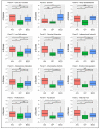Many Facets of Eating Disorders: Profiling Key Psychological Features of Anorexia Nervosa and Binge Eating Disorder
- PMID: 36975300
- PMCID: PMC10045239
- DOI: 10.3390/bs13030276
Many Facets of Eating Disorders: Profiling Key Psychological Features of Anorexia Nervosa and Binge Eating Disorder
Abstract
Objective. The present study employs a profile analysis to identify and compare psychological features and core eating disorder (ED) symptoms in clinical samples of patients with anorexia nervosa (AN) and binge eating disorder (BED) and the general population (GP). Methods. A sample comprising 421 participants (142 patients with AN; 139 patients with BED; and 140 participants from the GP) was surveyed with the Eating Disorder Inventory-3 (EDI-3). Individuals with AN and BED were recruited and tested during their first week of a multidisciplinary inpatient program for weight loss and rehabilitation at the 'Rete DCA USL Umbria 1' (Eating Disorders Services), Italy. Results. The findings suggest distinct patterns of symptom presentation between the three samples across all the EDI-3 dimensions-with both the AN and BED groups scoring significantly higher than the GP. Patients with AN registered greater scores in all the psychological trait scales and the drive for thinness ED-specific dimension of the EDI-3 compared with their BED counterpart-which, instead, scored higher in the bulimia and body dissatisfaction subscales. These data support the transdiagnostic nature of the main risk factors for the onset and maintenance of EDs-which would vary in severity levels-and the existence of disease-specific pathways giving rise to AN and BED. Conclusion. This study for the first time compares patients with AN and BED with a non-clinical sample on main ED psychological features. This might inform classification approaches and could have important implications for the development of prevention and early intervention programs.
Keywords: anorexia nervosa; binge eating disorder; eating behaviors; eating disorders; profile analysis.
Conflict of interest statement
On behalf of all the authors, the corresponding author states that there are no conflicts of interest.
Figures


References
-
- American Psychiatric Association . Diagnostic and Statistical Manual of Mental Disorders. 5th ed. American Psychiatric Association; Washington, DC, USA: 2013. - DOI
LinkOut - more resources
Full Text Sources

